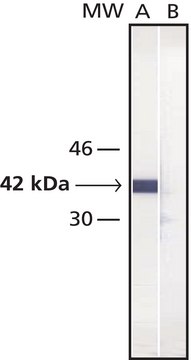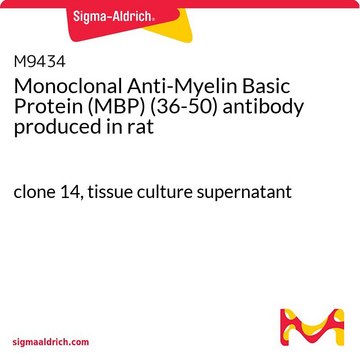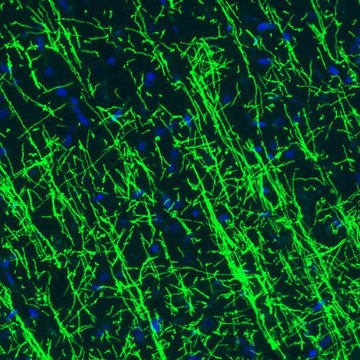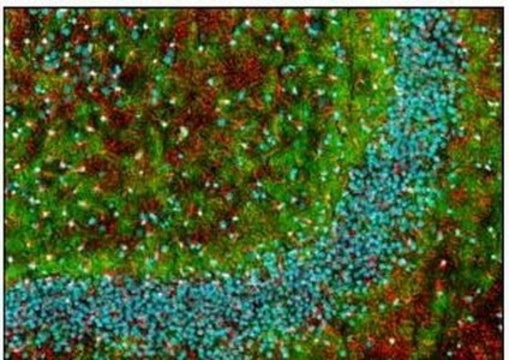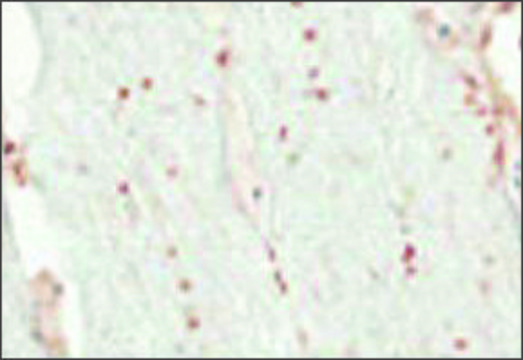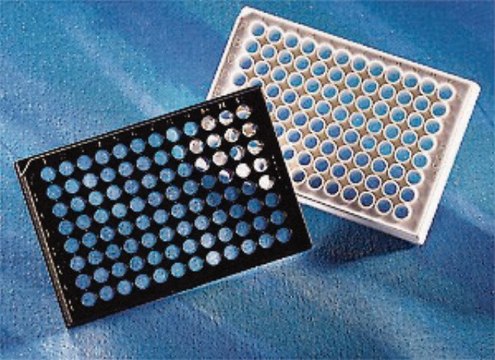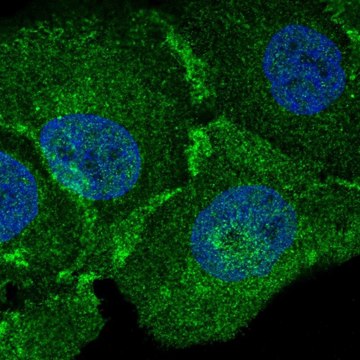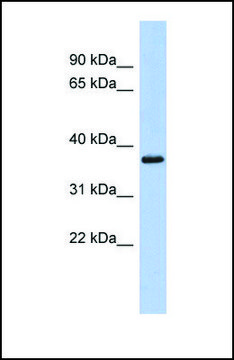推荐产品
生物来源
rat
质量水平
偶联物
unconjugated
抗体形式
purified immunoglobulin
抗体产品类型
primary antibodies
克隆
MBP 7G4, monoclonal
表单
buffered aqueous solution
分子量
antigen ~42 kDa
种属反应性
wide range
浓度
1.0 mg/mL
技术
immunoprecipitation (IP): suitable
indirect ELISA: suitable
western blot: 0.1-0.2 μg/mL using MBP recombinant protein
同位素/亚型
IgG2a
运输
dry ice
储存温度
−20°C
靶向翻译后修饰
unmodified
一般描述
MBP is part of a large class of proteins that aid in the uptake of small molecules. While it naturally resides in the periplasm, MBP can also be expressed at high yields in the cytoplasm. For different proteins, increased solubility, enhanced stability and markedly improved yields have been reported after fusion to MBP.
Monoclonal Anti-Maltose Binding Protein (MBP) (rat IgG2a isotype) is derived from the hybridoma MBP 7G4 produced by the fusion of mouse myeloma cells (P3X63Ag8.653) and splenocytes from rat immunized with MBP-fusion protein.1 The antibody is purified from culture supernatant of hybridoma cells grown in a bioreactor. Monoclonal Anti- Maltose Binding Protein (MBP) is specific for MBP.
特异性
Monoclonal Anti- Maltose Binding Protein (MBP) is specific for MBP.
免疫原
MBP-fusion protein
应用
Monoclonal Anti-Maltose Binding Protein (MBP) antibody produced in rat is suitable for:
- immunoblotting
- enzyme linked immunosorbent assay (ELISA)
- immunoprecipitation
Monoclonal antibodies recognizing specifically MBP are useful in various immunotechniques for identifying the expression of an MBP fusion protein in bacteria or in cells transfected with MBP fusion protein expressing vectors.
生化/生理作用
Maltose binding protein (MBP) tag is known to be used in genetic engineering to create a stable fusion product that does not appear to interfere with the bioactivity of the protein of interest or with the biodistribution of the MBP tagged product. The expression of polypeptides in-frame with maltose binding protein (MBP) allows for their easy purification from bacterial extracts under mild conditions, which employ a single affinity chromatographic step on amylose resin. This system and others based on the expression of fusion proteins utilize a specific protease cleaving site to facilitate correct cleavage of the fusion protein. Thus, the MBP system incorporates a factor Xa cleavage site at the carboxy terminus of the MBP sequence, and cleavage by factor Xa separates MBP from its partner protein. Many recombinant proteins have been engineered with MBP tags to facilitate the detection, isolation and purification of the proteins.
外形
Solution in 0.01M phosphate buffered saline pH 7.4, containing 15 mM sodium azide.
储存及稳定性
Store at -20 °C. For continuous use, the product may be stored at 2-8 °C for up to one month. For extended use, freeze at -20 °Cin working aliquots. Repeated freezing and thawing, or storage in “frost-free” freezers, is not recommended. If slight turbidity occurs upon prolonged storage, clarify by centrifugation. Working dilution samples should be discarded if not used within 12 hours.
免责声明
Unless otherwise stated in our catalog, our products are intended for research use only and are not to be used for any other purpose, which includes but is not limited to, unauthorized commercial uses, in vitro diagnostic uses, ex vivo or in vivo therapeutic uses or any type of consumption or application to humans or animals.
未找到合适的产品?
试试我们的产品选型工具.
储存分类代码
10 - Combustible liquids
闪点(°F)
Not applicable
闪点(°C)
Not applicable
法规信息
常规特殊物品
从最新的版本中选择一种:
分析证书(COA)
Lot/Batch Number
Overview of affinity tags for protein purification
Kimple ME, et al.
Current Protocols in Protein Science / Editorial Board, John E. Coligan ... [Et Al.], 73(1), 9-9 (2013)
Comparative analyses of ubiquitin-like ATG8 and cysteine protease ATG4 autophagy genes in the plant lineage and cross-kingdom processing of ATG8 by ATG4
Seo E, et al.
Autophagy, 12(11), 2054-2068 (2016)
T Ikeda et al.
Gan to kagaku ryoho. Cancer & chemotherapy, 13(4 Pt 1), 1044-1049 (1986-04-01)
A study of postoperative adjuvant chemotherapy according to cell type, combined with immunotherapy using PSK and OK-432 was conducted in 178 lung cancer patients who had undergone resection. BRM (PSK or OK-432) was selected by randomization. Chemotherapy was mainly performed
A bacterial cysteine protease effector protein interferes with photosynthesis to suppress plant innate immune responses
Rodriguez HJ, et al.
Cellular Microbiology, 14(5), 669 ?681-669 ?681 (2016)
Fusion tags for protein solubility, purification and immunogenicity in Escherichia coli: the novel Fh8 system
Costa S, et al.
Frontiers in Microbiology, 5, 63-63 (2014)
我们的科学家团队拥有各种研究领域经验,包括生命科学、材料科学、化学合成、色谱、分析及许多其他领域.
联系技术服务部门
